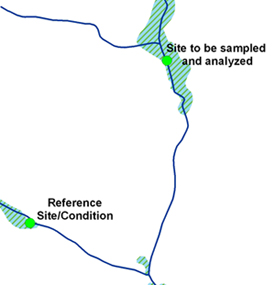 |
 |
Stream Reach Model Development Typically in stream assessments, a stream collection is compared to a reference condition to determine the extent of degradation or health. Based upon literature, choosing a nearby reference condition can be very challenging. From the graphic on the right, assessing a site based upon results obtained at a similar and close proximity location can be useful, however landscape alterations may be widespread throughout the watershed and may inhibit finding an appropriate reference stream/condition.
Current reference stream models for upper and lower Coastal Plain, lower Piedmont, eastern shore, and Shenandoah basin regions include variables representing fish and macroinvertebrate assemblage structure, instream habitat, and geomorphology, and have substantial explanatory power (R2 up to 0.74). This integrative approach eliminates many of the limitations typically associated with traditional bioassessment methods (e.g. RBP, IBI), including lack of appropriate reference sites and stream classifications that are based on a single ecological component (e.g. biotic versus abiotic, fishes versus macroinvertebrates) that may not be diagnostic under many conditions. |
|
| This document was last updated on
November 7, 2008
Virginia Commonwealth University Center for Environmental Studies 1000 West Cary Street - Richmond, Virginia 23284 - 804-828-7202 (Phone) - 804-828-1622 (fax) - Contact the INSTAR team |
|


